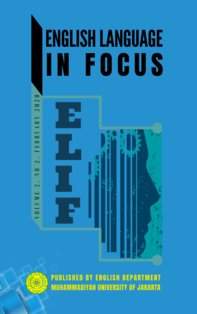Web-Based Music Study in Boosting Active Listening
DOI:
https://doi.org/10.24853/elif.2.2.97-102Keywords:
listening skills, Web-based music study, teaching listening.Abstract
The purpose of this research was to prove that using a web-based music study is effective in boosting active listening. This research conducted in Private Elementary School Khalifa IMS Tangerang Selatan. The population of this research is third-grade students, and the sample is P3C consists of 25 students. The method of this research is quantitative method and using pre-experimental design. To collect the data, the writer used a pre-test, and post-test that given to the students. The resulting score of the data indicated that, the total score of students in the pre-test was 1338 with the average were 53.52. The lowest score of the pre-test was 37 and the highest score was 60. The total score of students in the post-test was 2211 with the average were 88.44. The lowest score of the post-test was 80 and the highest score was 97. It is significantly different from the result of pre-test and post-test scores. The results of the pre-test and post-test were calculated by using manual statistically. The calculation indicated that t – observe were 4.79 with t – tables were 1.70 and the significance 0.05. Therefore, the alternative hypothesis (H1) is accepted and the null hypothesis (H0) is rejected. The writer concluded that using Web-based music studies in teaching English was effective to improve students’ listening skills.References
Atiyah, F., & Izzah, L. (2019). A Comparative Study on the Effectiveness of Using Direct and Audiovisual Methods for Enhancing Students Listening Comprehension. English Language in Focus (ELIF), 2(1).
Bodie, G. D. (2011). The Understudied Nature of Listening in Interpersonal Communication: Introduction to a Special Issue. International Journal of Listening, 25(1–2), 1–9. https://doi.org/10.1080/10904018.2011.536462
Bond, C. D. (2012). An Overview of Best Practices to Teach Listening Skills. International Journal of Listening, 26(2), 61–63. https://doi.org/10.1080/10904018.2012.677660
Hadi, M. S. (2019). The Use of Song in Teaching English for Junior High School Student. English Language in Focus (ELIF), 1(2), 107–112.
Hare, K., & Smallwood, J. (2008). Music and Learning. Retrieved from http://www.kaizen-training.comlfree/TtT _Hare_Smallwood. pdf.
Horn, C. A. (2007). English Second Language Learners: Using Music to Enhance the Listening Abilities of Grade Ones (University of South Africa). Retrieved from https://core.ac.uk/download/pdf/43165719.pdf
Lam, J., Ng, K. K., Cheung, S. K. S., Wong, T. L., Li, K. C., & Wang, F. L. (2015). Technology in Education : Technology-Mediated Proactive Learning : Second International Conference, ICTE 2015, Hong Kong, China, July 2-4, 2015, Revised selected papers. New York: Springer.
Okudaira, A. (1999). A Study on International Communication in Regional Organizations: The Use of English as the “official” Language of the Association of Southeast Asian Nations (ASEAN). Asian Englishes, 2(1), 91–107. https://doi.org/10.1080/13488678.1999.10801020
Parlakian, R. (2010). Beyond Twinkle, Twinkle: Using Music with Infants and Toddlers, Young Children. National Association for the Education of Young Children, 65(2), 14–19. Retrieved from https://eric.ed.gov/?id=EJ898687
Rost, M. (2013). Teaching and Researching: Listening. Newyork: Routledge.
Sugiyono. (2017). Metode Penelitian Kuantitatif, Kualitatif, dan R&D. Bandung: Alfabeta, CV.
Thomas, C. (2015, November). Active Listening: Teaching with Music.
Yang, J. (2013). English Language Teaching. English Language Teaching, 6(7), 19–25. https://doi.org/10.5539/elt.v6n7p19
Downloads
Published
Issue
Section
License
Authors who publish with this journal agree to the following terms:
- Authors retain copyright and grant the journal right of first publication with the work simultaneously licensed under a Creative Commons Attribution License that allows others to share the work with an acknowledgment of the work's authorship and initial publication in this journal.
- Authors can enter into separate, additional contractual arrangements for the non-exclusive distribution of the journal's published version of the work (e.g., post it to an institutional repository or publish it in a book), with an acknowledgment of its initial publication in this journal.
- Authors are permitted and encouraged to post their work online (e.g., in institutional repositories or on their website) before and during the submission process, as it can lead to productive exchanges, as well as earlier and greater citation of published work (See The Effect of Open Access).


